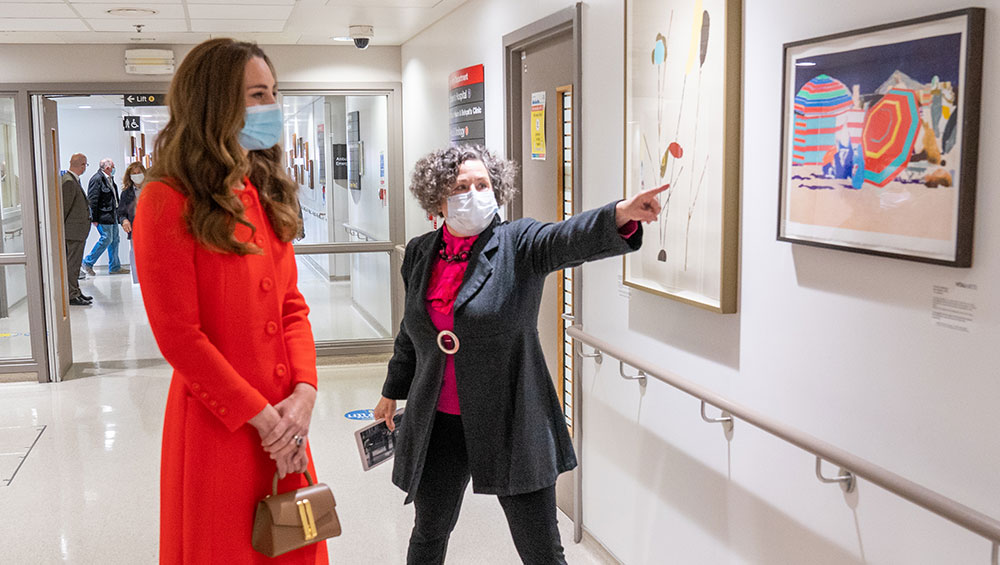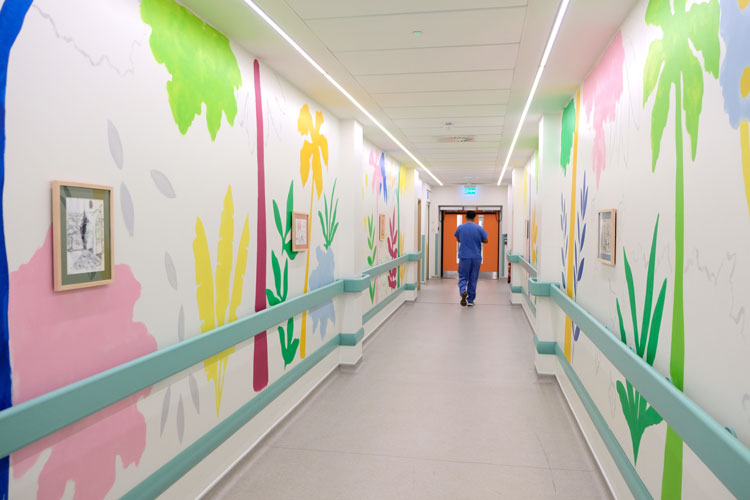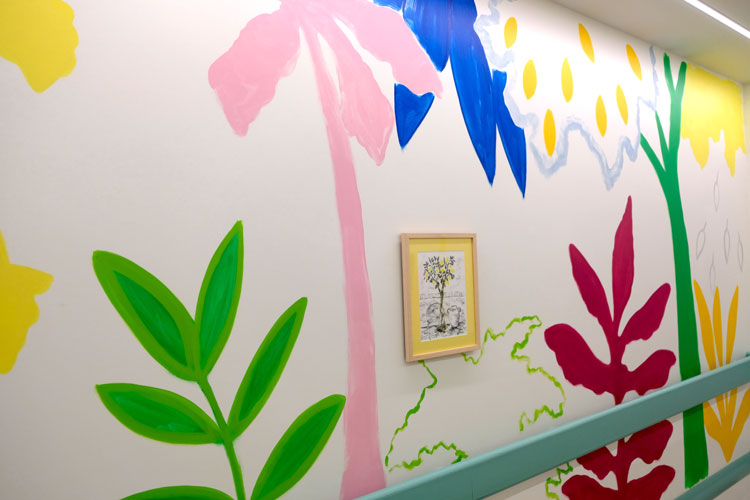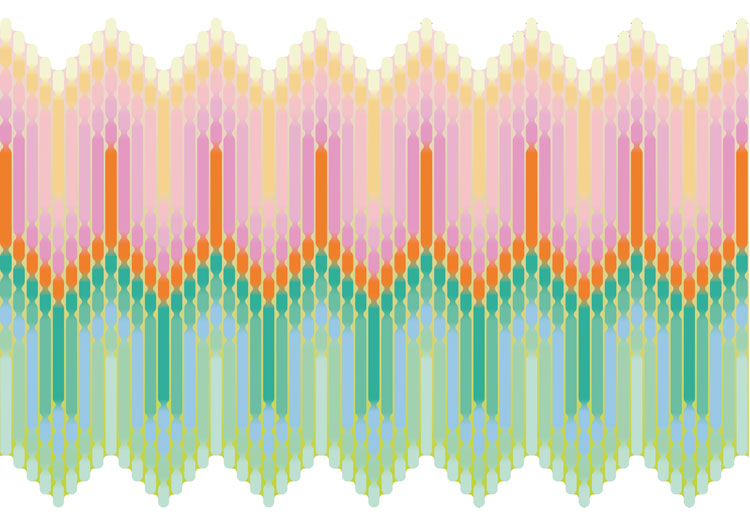
The Duchess of Cambridge meeting with Catsou Roberts, director of Vital Arts, at the Royal London Hospital. Photo: Arthur Edwards.
by DAVID TRIGG
The powerful contribution that art can make to health is widely acknowledged. As countless studies have shown, interaction with the arts and creativity boosts wellbeing, promotes resilience and supports clinical aims. Founded in 1996 and embedded within Barts health, the largest NHS trust in London, Vital Arts has been enhancing London’s hospital environments and improving the experience of patients for a quarter of a century. Its innovative programme, featuring exhibitions, site-specific commissions, music, dance, literature, craft and artist residencies, has blazed a trail in the burgeoning field of arts and health, setting the tone for other organisations that have followed suit.

Cara Nahaul, Canopy and medicinal flora, 2020. Paint, vinyl, and framed charcoal drawings. Custom House Ward, Newham Hospital. Photo: Vital Arts.
As one of the UK’s leading arts and health organisations, Vital Arts works with five hospitals in east London – The Royal London, St Bartholomew’s (Barts), Mile End, Whipps Cross and Newham university hospital – and serves more than 2.5 million people. Partnering with artists, medical staff, patients and other stakeholders, it aims to create positive and uplifting experiences for hospital users as well as staff and the wider healthcare community. Hurvin Anderson, Rana Begum, Rhys Coren, Ruth Ewan, Peter Liversidge, Darren Almond, Cornelia Parker and Roger Hiorns are among the dozens of artists who have made new and ambitious works for the charitably funded organisation.
In July 2017, parliament’s landmark report Creative Health: The Arts for Health and Wellbeing called for a greater awareness of the benefits that engagement with the arts can bring to patients and staff within healthcare settings. Vital Arts has been ahead of the curve for years, most recently under the leadership of Catsou Roberts, who has been its director since 2015. She spoke to Studio International about the myriad ways in which the organisation works with artists to bring the transformative power of art to new audiences, both within and beyond the hospital walls.
.jpg)
Lilah Fowler, Lantern Forest, 2019. Vinyl. Whipps Cross Hospital. Photo: Ollie Harrop.
David Trigg: Vital Arts has been enhancing hospital environments and improving the patient experience for 25 years. How has the field of arts and health changed since the organisation was founded?
Catsou Roberts: The benefits of art in healthcare are now widely recognised, and the field is more formalised. Arts and health (often rendered with a logo-like ampersand) is a specialism within public art, and projects are increasingly ambitious. In terms of the visual arts, the field has evolved well beyond mirror-plating “pictures” up between noticeboards. We think in terms of generating projects, commissioning site-specific work, developing hospital-wide art strategies that extend across the entire campus and adjoining public realm. We consider overall design and architecture, as well as the social and physical environment of the surrounding locale. Not every hospital has an embedded art service, and may rely on renting artwork, expensive art consultants, or the occasional volunteer who might know a Monet from a Manet or a print from a poster. My hope is that the field continues to attract art professionals (who might have traditionally sought museum careers) to bring their curatorial knowledge, research interests and cultural expertise to a wider audience.
.jpg)
Richard Wentworth, The Light of Day, 2011. Digital prints, antiqued mirror, walnut boxes and nails. Barts Hospital. Photo: Owen Richards.
DT: Before joining Vital Arts in 2009, you worked as a curator in contemporary art institutions, including Bristol’s Arnolfini Gallery. What led you to move away from galleries and into the world of arts and health?
CR: When I started – initially for a six-month maternity cover – Vital Arts was beginning a project with Darren Almond, whose work I had shown at Arnolfini and for whom I have deep esteem. Vital Arts had been working with other wonderful artists and I immediately recognised the thrilling potential of bringing significant art to vast audiences, who might not otherwise access contemporary culture. Rather than waiting for an audience to cross the threshold of a museum, the audience is already there, waiting – literally. Our five east London hospitals serve 2.5 million people, in some of the most disadvantaged communities in the UK. That captive audience might be receptive, yet underserved by the culture sector. This is the intersection of art and “reality”, and it resolves many of my reservations about the “art world”. It is the reification of endless discourse about praxis, social engagement and community outreach. I want to form a bridge between art scepticism and the eye-catching, mind-tingling experience that art can ignite. For me, it was simply a question of bringing years of curatorial, programming and creative production experience to a different context – and one that is never ex nihilo! We never want for context nor audience, which is why I’m still in the job 12 years later.
DT: You have said: “It behoves an NHS trust, delivering state-of-the-art healthcare – and which sees itself as ‘world class’ – to display museum-quality artwork.” You clearly believe that hospitals should be as ambitious as possible with the art they present, but many clinical environments pose challenges to this – these are not white-cube spaces after all.
CR: There is an acute strain of horror vacui within the NHS, and clutter is a serious impingement on wellbeing, disrupting care in multiple ways. Hospitals are key civic spaces and fundamental to communities. If hospital management invites in contemporary art, then it must enable it to function – to do its job delivering the wellbeing benefits that art of consequence can offer – within an appropriate visual environment. I’m beginning work with a neurologist, Professor Parashkev Nachev, to develop policy mandating the decluttering of hospital walls. We will outline the detrimental effects that an overload of information can have, looking at the clinical and psychological impact on patients barraged with noticeboards, signage and messaging vying for attention. We will establish principles of visual organisation for clinical spaces, which we hope will be adopted across the NHS and used as a directive for best practice.
,-2019,-Vinyl-wallcovering,-framed-prints,-Barts-Health-Orthopeadic-Centre,-Newham-photographer-Michael-Whitestone.jpg)
Rhys Coren, Love is the message (dedicated to the NHS and the staff at BHOC), 2019. Vinyl wallcovering, framed prints, Barts Health Orthopeadic Centre, Newham. Photo: Michael Whitestone.
DT: Each project you commission is different, but how do you typically begin, and what factors need to be taken into account when developing commissions suitable for clinical environments?
CR: All our projects are designed to support wellbeing and assist medical goals. They range in scale from commissions for single counselling rooms to entire clinical units (incorporating waiting areas, treatment rooms, corridors, and so on), to expansive new buildings, such as the 17-storey PFI addition to the Royal London hospital which opened in 2012, or our new Whipps Cross Hospital, still in development. We always begin with site visits (or poring over architectural plans if yet unbuilt) and discussions with our clinical colleagues to learn about patient demographics, conditions being treated, possible diagnoses, as well as the likely psychological impact on those using the particular spaces where we will introduce artwork. When appropriate, we also consult service users for patient/family perspectives. We evaluate the practical possibility of integrating artwork that will provide mind-opening, life-affirming encounters with contemporary culture. We then identify possible artists to approach, develop a brief, and secure funding (crucial, given we don’t receive an art budget from the NHS). All this informs the curatorial guidance we offer during the artistic process – and ultimately the outcome of the final artwork. We’ll work on several projects simultaneously, covering all five hospital sites, each with an array of buildings.
DT: Experiencing art in a hospital is quite different from visiting a gallery or museum. Viewers are usually there by necessity rather than choice, so their engagement is more passive than intentional. Inevitably, some patients will resent being confined to the hospital environment. How do you negotiate these tensions when commissioning artworks?
CR: We will be calculating how any artwork might cross someone’s field of vision. So, an artwork in a corridor observed en passant by patients rushing to an appointment, will have entirely different implications than artwork within the viewing room where family see the recumbent corpse of their loved one. Isolation rooms, where patients are confined for days, sometimes weeks, require art that continues to reverberate with extended viewing, such as the subtle and resonant work by Amalia Pica in the oncology ward at Barts hospital, or the engrossing installation by cartoonist Tom Gauld in the same hospital’s cystic fibrosis unit. Museum-style didactic labels accompany each work and facilitate interpretation. Ultimately, the aim is to assist expeditions of the imagination.
DT: With so many artists you could potentially commission, how do you select those with whom you work?
CR: Just like any thoughtful curatorial practice, Vital Arts undertakes extensive research and looks across the landscape of contemporary art to identify the artists we approach. We engage with current creative practice, constantly seeking artists unfamiliar to us. We focus on artists based in the UK, or who have a connection to and appreciation of the NHS. Given our hospitals are in east London, we have “local artists” aplenty. But, crucially, we intentionally work with artists who have not previously made work for hospitals, and often have never been commissioned. This undermines the predictability of so much public or “hospital art” – too easily rendered as the cut-and-paste of existing work. Such risk-taking requires vision, imagination and, above all, trust from our clinical colleagues whose day job doesn’t normally involve creative production.
DT: I imagine most artists you approach are positive about the work of Vital Arts.
CR: Those we approach are interested in the challenging context of a hospital – or at least, the deep running histories of Barts (St Bartholomew’s in the City of London was founded in 1123), or the Royal London in Whitechapel with its own fascinating background of immigration, not to mention our hospitals in Mile End, Waltham Forest and Newham. Vital Arts invites artists with a commitment to research and experimentation. We are not interested in blue-chip artists depositing a signature work. Having said that, many of the artists we have shown over the years became well known – testament to the organisation’s foresight. Ideally, every commission in healthcare would forge new paths and extend opportunities to different artists to grow through a first encounter with a hospital context. Many have described how confronting such intense and complex circumstances has occasioned innovation. Richard Wentworth, for example, observed that his commission for Barts Hospital in 2011 (The Light of Day) enabled him to explore new avenues because it was his first artwork for a healthcare setting.
.jpg)
Richard Wentworth, The Light of Day, 2011. Digital prints, antiqued mirror, walnut boxes and nails. Barts Hospital. Photo: Owen Richards.
Similarly, Cara Nahaul remarked that working with Vital Arts to deliver her first project within a clinical space (Canopy and Medicinal Flora, 2020) gave her confidence to expand and emboldened her practice. Invention is key to generating meaningful artworks – artworks that then become part of a collection that serve as a public amenity for the local community. I feel that it is our duty to the NHS, to our patients and staff, and to future generations of services users, to elicit the production of remarkable artwork.

Cara Nahaul, Canopy and medicinal flora, detail, 2020. Paint, vinyl, and framed charcoal drawings. Custom House Ward, Newham Hospital. Photo: Vital Arts.
DT: Is it important for you to develop working relationships with artists that extend beyond single commissions?
CR: Indeed. Some artists will develop several projects that are each an iteration of their original research. Sometimes we serve as the springboard for other work that will exist outside the hospital – such as a performance by Peter Liversidge featuring Phill Jupitus reading a collection of health-related jokes at Tate Modern, a film by Catherine Yass produced by the Wellcome, or a perfume created by Jacques Nimki made from wildflowers found around Whitechapel. I’m interested in supporting artists by offering them the hospital as a context. That relationship also extends to limited editions that we produce with the artists we commission. Lothar Götz, for example, was first commissioned to make a billboard for the historic Barts Square in 2007 (this followed billboards by Pae White in 2006 and Julian Opie in 2002). He went on to create more work for us, including prints that we produced as editions to raise money for our programmes, as well as the Terrence Higgins Trust. All proceeds from our editions are shared with health charities nominated by each artist.
.jpg)
Lilah Fowler, Lantern Forest, 2019. Vinyl. Whipps Cross Hospital. Photo: Ollie Harrop.
DT: Lilah Fowler was your first artist-in-residence at Whipps Cross hospital, which allowed her the time and space to develop an innovative installation called Lantern Forest, in which images of local flora and fauna are incorporated into the windowpanes along the hospital’s main public corridor. What advantages do residencies hold for Vital Arts and is this an area you want to develop further?
CR: Residencies give artists the opportunity to deeply engage with a particular hospital or service within. It also provides a framework for accessing the trust’s extensive archives (as did Wentworth, Liversidge, Catherine Bertola and Ilana Halperin), and exploring our buildings (as did Yass, Franziska Lantz, Anka Dabrowska and Roger Hiorns). It is an unstructured arrangement, which I would like to further expand. It extends to other disciplines: Lemn Sissay was a poet-in-residence and we have dancers and musicians-in-residence. Next year, we will welcome the musician, broadcaster and writer Eddie George who was a founder of the Black Audio Film Collective. I have invited Robin Klassnik, who founded Matt’s Gallery in 1979, to be our first curator-in-residence for a palliative care centre. My idea was to develop a reservoir of wall-based works (an “art library”) from which patients and/or families can select what is displayed in their rooms – and change them daily if so desired. This will provide some agency to those confined to a single space during their final days. I thought of Robin, who is an international figure in contemporary art, but also a long- time local resident and a regular patient at Whipps Cross hospital in Waltham Forest.
DT: What role does Vital Arts’ participation programme play in the life of Barts health?
CR: Not unlike the residencies, we also bring artists into the school at the Royal London (as one of the UK’s largest children’s hospitals, we have educational provision for chronically ill pupils). Sam Ayre, Shiraz Bayjoo, Jessica Voorsanger, Faisal Abdu’Allah, Bob and Roberta Smith, Leo Fitzmaurice and many others created work for Vital Arts based on their time in the classroom. Such engagement is part of our active programme that features dance, music, literary projects and creative workshops – extending to gardening-related projects and a cookbook of renal-friendly recipes developed with patients.
DT: After 25 years, Vital Arts has an established international reputation for excellence within the clinical environment. How are you active beyond the hospital walls?
CR: We are regularly approached by UK and international organisations seeking curatorial advice or asking to include our projects in exhibitions or books. These have come from Germany, Japan, Sweden, Greece, Denmark, Poland, Italy and the US. Personally, I serve in various advisory roles, including the art advisory group for Maggie’s cancer support charity, and I enjoy jurying public realm design competitions, art awards and academic crits. I contribute to publications on arts and health, and regularly lecture to art and non-art audiences alike. I am particularly passionate about the teaching I do with medical students to help build visuality and encourage creativity. The rest of my team is increasingly out there, also giving talks, appearing on programmes and sitting on panels. We are delighted to advocate for arts and health, and to discuss our particular ambition for it. Occasionally, we are asked to undertake consultancy work (for public art or other health facilities), but we only accept if we have spare capacity.
DT: How has the work of Vital Arts been affected by the pandemic?
CR: As an arts organisation embedded within the NHS, Vital Arts is busier than ever, and we’ve expanded our focus on staff. Although forced to temporarily suspend our patient participation programme, which entails personal interaction, there has been a flurry of visual art projects coming on to the horizon since March 2020. We finished a few during lockdown, including unit-wide installations by Rhys Coren and Nahaul. Of course, restricted access, which has been devastating for families unable to visit loved ones, has also hampered our site visits – and it did mean that when the Duchess of Cambridge visited us in May 2021, rather than giving her a tour of installed works in patient areas, I had to re-stage some of the projects in a central room at the Royal London in order to convey a sense of our work during our meeting.
DT: Interest in the field of arts and health intensified as the Covid-19 pandemic swept the world in 2020. This was combined with a greater appreciation for NHS staff, especially those on the frontline. Vital Arts responded with #100NHSRooms, an initiative that saw artists donating artworks to display across hospital staff rooms within Barts health NHS trust. How did the project get started?
CR: Given the additional pressure experienced by our clinical colleagues, the trust sought to enhance the staff rooms throughout our hospitals. At the same time, the artist Shezad Dawood, who was a driving force behind the project, contacted me offering to ask fellow artists to donate work to support the NHS. We quickly devised a plan, bringing in Nick Hackworth, director of the curatorial platform Modern Forms, and the project took off. Within days, Shezad and Nick had commitments from dozens of artists, many of whom made new works specifically for the project, including Rana Begum, Victor Burgin, Haroon Mirza and Mark Wallinger among others. The generosity of the artists, as well as Simon Beaugie, who kindly donated framing services, and Pelham Communications, which provided free PR support, was staggering.
DT: How was the project received by NHS staff?
CR: It boosted staff morale and created a sense of pride and ownership. But I offer a simple anecdote: a staff member at the Royal London recently revealed: “Since starting work at the Royal London, and seeing so much contemporary art here, I’ve begun to realise that I like it.” Pre-Covid, we received requests for docent-like tours of the artwork from clinical colleagues. We’d guide them to discover works in parts of the building they wouldn’t normally visit. I am trying to organise separate tours for the cleaners (who, after all, have regular physical contact with all our art) as well as the security guards and the porters – prompted by one in particular, who told me he likes to discuss the artwork with patients as he wheels them around Barts. One tour I’m particularly keen to do is with the helicopter emergency medical service team, who have promised a visit to the helicopter pad, in exchange.
DT: What exciting new projects will patients, visitors and staff be experiencing at Barts Health hospitals in the coming year?
CR: Optimistically, our participation programme will be back on track so we can again bring dance, music and workshops directly to patients. We are looking into commissioning new dance work from Studio Wayne McGregor, and have several collaborative partnerships in development, including with an important archive of nature sounds. This is connected to my perennial aspiration to air commissioned audio work on our hospital radio stations. We are working on several mental health rooms across our A&Es, and commissions by Cecilia Charlton for an emergency care unit, and one by Aliyah Hussain throughout a residential building recently converted into doctors’ “on call” rooms.

Cecilia Charlton, Villa Maravillosa. Detail of installation in progress. Photo courtesy Vital Arts.
This month we announce our selected artist for a commission in the main entrance to Newham hospital, and we are now long listing for a highly unusual project: a memorial to commemorate organ donation. The new building at Whipps Cross, hopefully opening in 2026, will include hospital-wide art strategies integrating work into the fabric of the structure, as well as into the public realm. We’ll be busy! Looking even further ahead, and more widely, the government’s (putative) new hospital building programme will be the opportune occasion to radically transform civic space and the hospital experience by raising the bar for art and architecture. Much of it to be delivered, no doubt, by practitioners yet to emerge.
Click on the pictures below to enlarge